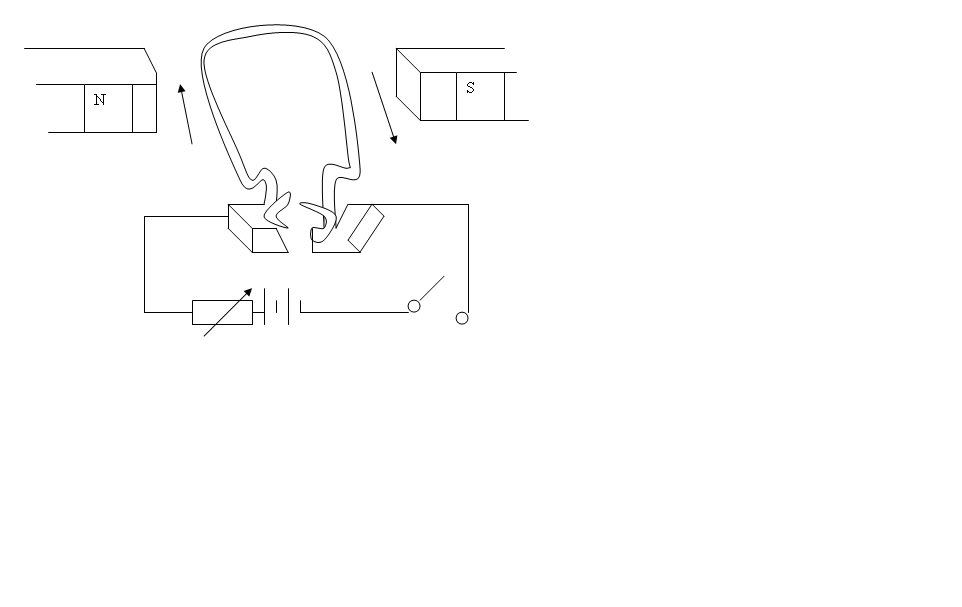Electromagnetism - D.C motor
-
I have some queries regarding the workings of the D.C motor. I'll first describe to you the process (from the textbook) and highlight the parts where I do not understand.
When the circuit is closed, the current flows from the battery through P and X through the coil and back to the battery through Y and Q. Using Fleming's left-hand rule, the left side of coil experiences a downward force and the right-side experiences and equal upward force. (P refers to the the part where the coil is connected to the rectangular box on left side. Q referes to the box on the right side. They are the carbon brushes. X is the commutator (attached to P) on left side while Y is the commutator on the right side, attached to Q)
This pair of forces makes the coil rotate anti-clockwise until it reaches a vertical position. At this poin t the current is cut off because neither X nor Y is in contact with P or Q
The half ring Y will then touch P while X comes into contact with Q. This is the same situation we started except that P and Q have exchanged places. Again the turning forces will act. Thus the coil continues to rotate in the same direction. Note that the direction of current in coil reverses each time the coil passes the vertical position.
1. For the first sentence highlighted, I tried to use Fleming's Left hand rule but failed to get the force. The magnetic force is acting in a left to right direction but what about the current? Is it pointing to the left side (since positive end of battery is at the left side)? Would be great if someone woulld illustrate(in a diagram hopefully) where the fingers and thumb point for the forces to act upwards and downwards. I am just not sure of the current's direction
2. Secondly, it said the direction of current in coiil reverses.... Does it mean the current now also flow from -ve to +ve side of battery(electron flow)? I really don't understand this part. Please help. Thanks.

-
Just follow the direction that the current is flowing in the coil. Your diagram is already showing the correct directions of flow. In this case, Current should be pointing "Inwards" (WHY? Read further), Field to the Right, and there you have the Force.
Your diagram, although correct in directions, is rather awkward in portraying the coil. I'll take a better art from Google.
NOTE: Meh, I just realised. You may think that the rotation of coil is wrong. Rather, if you think so, you're wrong. The line in the coil "electron motion" actually means the movement of electrons. If you want the conventional current, you have to point your Current in the other direction, which is "Outwards".
Physics is just a matter of using your brain to VISUALISE, isn't it?
Imagine the first scenario.

Notice how AB and CD shift sides and shift in DIRECTION OF CURRENT. That's basically the whole point.

Credits to http://student.britannica.com/comptons/art/print?id=53254&articleTypeId=0 for image
-
Originally posted by Garrick_3658:
Just follow the direction that the current is flowing in the coil. Your diagram is already showing the correct directions of flow. In this case, Current should be pointing "Inwards" (WHY? Read further), Field to the Right, and there you have the Force.
Your diagram, although correct in directions, is rather awkward in portraying the coil. I'll take a better art from Google.
NOTE: Meh, I just realised. You may think that the rotation of coil is wrong. Rather, if you think so, you're wrong. The line in the coil "electron motion" actually means the movement of electrons. If you want the conventional current, you have to point your Current in the other direction, which is "Outwards".
Physics is just a matter of using your brain to VISUALISE, isn't it?
Imagine the first scenario.

Notice how AB and CD shift sides and shift in DIRECTION OF CURRENT. That's basically the whole point.

Credits to http://student.britannica.com/comptons/art/print?id=53254&articleTypeId=0 for image
Thanks. I'm pretty clear about the part regarding the change in current direction. However, I'm still unsure as to which part the finger representing the "current" should point for the question on D.C motor using Fleming's left-hand rule. It would be good if you/someone else could explain it to me again.
Thanks again.
-
Just visualise a 3D region for the "Field" and "Current" on the diagram. You'll need the almighty eagle to do a diagram though.
-
Originally posted by anpanman:
Thanks. I'm pretty clear about the part regarding the change in current direction. However, I'm still unsure as to which part the finger representing the "current" should point for the question on D.C motor using Fleming's left-hand rule. It would be good if you/someone else could explain it to me again.
Thanks again.
You really have to visualise it in a 3D way.
For your question 1, B-field is from left to right. Current is into the paper for the left side of the coil. Using Fleming's left hand rule, the force (thumb) will point downwards.
For the right side of the coil, current is coming out of the paper. Using FLH again, the force (thumb) will point upwards.
Main thing about FLH is it's "3D ness" and that all fingers are perpendicular to each other.